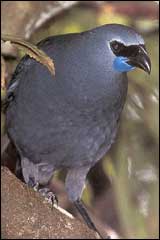|
|
|||
|
||||
|
Updated: September 6, 2001 |
|
|
|||||||||||||||||||||||||||||||||||||||||||||||||||||||||||||||||||||||||||||||||||||
 Kokako were first bred at the National Wildlife Centre at Mt Bruce in December 1986 |
|
|
New Zealand has an ancient family of birds called wattlebirds. Only the kokako and saddleback remain, as the huia became extinct at the beginning of the 20th century.
All three wattle birds were once widespread throughout New Zealand's mainland and island forests.
Saddlebacks are medium sized birds, with a conspicuous chestnut-coloured saddle on its back, and orange, "fleshy" wattles either side (gape) of its throat. They are found mostly in the middle and lower layers of the forest, often on the ground, probing through dead wood and leaf litter for weta, grubs and other insects. They also eat fruits of various forest trees, such as kawakawa and coprosma.
Kokako are a blue-grey bird with distinctive blue wattles at the gape of its throat. It too eats insects, leaves, fruits and berries. It is most often found running along branches and bounding through the forest rather than on the ground.
Mammalian predators especially rats, stoats and possums saw the extinction of the huia and the rapid decline of kokako and saddlebacks.
Captive breeding of kokako and saddlebacks have been successfully undertaken at Mount Bruce and safe populations have been established on offshore islands such as Tiritiri Matangi.